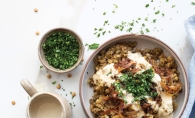Plymouth resident Steve Greenberg’s cooking journey began with scenes that sound like they could come out of a Shakespearean tragicomedy. Every year for the Jewish High Holidays, Greenberg’s family would gather and enjoy the traditional Eastern European food that they cherished. The holidays were times when the extended family would get together, celebrate and enjoy each other’s company.
The food was prepared by Greenberg’s three aunts—Shirley, Betty and Esther. Chicken soup, brisket, potato kugel—all the time-honored favorites were served—but there was a twist. The holiday meals guaranteed delicious, but beneath the savory flavors there was a fierce competition.
“It could take a turn for the testy,” says Greenberg. “Each of the aunts tried to outdo the others.
Every year, the family would decide the ‘bests of,’” says Greenberg. “’This year, Aunt Shirley’s brisket is the best,’” for example, comparing the current year’s offering with the briskets of years past; “Aunt Betty’s kugel is the best, and so on, with each of the dishes.”
“One year, Aunt Esther made a sponge cake,” recalls Greenberg. “There it sat on the table, and Aunt Shirley said it looked like it wasn’t going to hold together. Esther, naturally, insisted that it would, but Shirley just stuck her hand on top of the cake and smushed it down, and of course, it fell completely apart. To prove her point, kind of,” says Greenberg. “So there was love and warmth and all that with the food, but also there was a level of, ‘Watch out! This is serious!’”
Greenberg loved his aunts’ recipes, but he felt the bar was set impossibly high. When he set up his own household and it was time to create his own holiday feasts and traditions, he reached for “Out of Our Kitchen Closets: San Francisco’s Gay Jewish Cooking,” a cookbook put together by congregants of San Francisco’s Congregation Sha’ar Zahav. Greenberg explains that he started with the cookbook’s recipes, and gradually modified them to make them his own.
As a cantorial soloist who has been leading prayer since his bar mitzvah, Greenberg has always had a deep love for the Jewish holidays and for helping create meaningful celebrations for other people. Greenberg and his husband, Keith love hosting, and says he and Keith are famed for their yearly Passover seder, to which an invitation has become a coveted prize among their community.
While there might be a touch of friendly culinary competition among Greenberg and his friends, he says, “It’s never quite reached the level of the aunts.” Greenberg hesitates a moment and laughs. “Well, the competition never gets that intense among my friends, but for the men who wrote the “Out of Our Kitchen Closets” it seems to me that maybe it’s reached that level!”
Greenberg’s gefilte fish recipe, a dish that occupies for Jews somewhat the same position as lutefisk for people of Scandinavian descent—part weird “why am I eating this” and part time-honored tradition, is one of his crowd-pleasing recipes. Gefilte fish (“gefilte” means “stuffed" in Yiddish—it’s a dish traditionally made with deboned carp, pike or other white fish.) Many American Jews’ idea of gefilte fish is a version that comes in a jar, that to some, looks like a greyish, gelatinous mass. Greenberg’s is nothing like that, and while it’s a bit labor-intensive, it’ll have your guests asking for seconds. You’ll never be afraid of gefilte fish again.
Three Ribbons Gefilte Fish Loaf
Start to finish: 14.5 hours (including 12 hours or overnight chilling time)
Active time: 2.5 hours
Servings: 12-16
2 loaves (20-ounce frozen tube) of uncooked white gefilte fish
1 loaf (20-ounce frozen tube of red (salmon) gefilte fish. (It’s usually available at supermarkets with kosher sections around major Jewish holidays, but if not, substitute 20 ounces canned salmon, with bones and any skin removed.
3 large eggs (+ 2 additional if using canned salmon)
Prepared red horseradish sauce (optional)
3 Accompaniments:
1-1/2 teaspoons or more of capers
1-1/2 teaspoons or more of green olives, chopped
1-1/2 teaspoons or more of black olives, chopped
3 Seasonings:
1 teaspoon of parsley flakes
1 teaspoon of chopped dill
1/3 teaspoon of paprika
3 Garnishes:
1 medium cucumber, unpeeled, sliced very thin
1/2 teaspoon of chopped, fresh dill
1-1/2 teaspoon of fresh parsley cut 1/4 inch to 1/2 inch
Pre-heat oven to 350 degrees.
Lightly spray one 9-inch square or 8-inch round baking pan (springform or other pan with a push-out bottom) with cooking spray
In a mixing bowl, place one of the loaves of white gefilte fish, thawed, and 1 egg, 1 of the accompaniments and 1 of the spices. (You choose which to pair together.) Mix well by hand and place in the baking pan, shaping the mixture flat and evenly to fit the entire square or circle of the pan
In a clean mixing bowl, place the loaf of thawed salmon or the canned salmon, and 1 egg (if using frozen) or 3 eggs (if using canned), and 1 of the remaining accompaniments and spices.
Mix well by hand and place in the baking pan atop the white gefilte fish layer, shaping it flat as with the previous layer
In a clean mixing bowl, place the remaining loaf of white gefilte fish, thawed, and 1 egg, and the remaining accompaniment and spice. Mix well by hand and place in the baking pan on top of the salmon layer, shaping it flat as with the other 2 layers.
Bake for 1 hour. Remove from oven and place overnight (or at least 6 hours) in refrigerator to cool thoroughly. (Do not remove from pan before chilling.)
When it is cool, place the baking pan upside down on your serving plate and unlatch spring or push bottom to release the loaf on to the plate.
With a knife, skim off the fat that will have formed on what is now the top of the loaf.
Top with the cucumber slices, overlapping them and covering the entire top surface
Add the dill and parsley garnishes and serve.
Serve with red horseradish if desired.
Chicken Soup with Matzo Balls Greenberg
Start to finish: 1 hour prep time and overnight (8 or more hours) for simmering
Servings of soup: About 24 1 cup servings
Servings of matzah balls: 24
For the soup:
3 quarts of cold water (and additional if needed)
1 large yellow onion, chopped finely (food processing is okay)
1 turnip, chopped finely (food processing is okay)
1 cup chopped fresh parsley
Fresh parsley sprigs to garnish individual bowls
1/3 cup chopped fresh dill
3 stalks celery, chopped finely (food processing is okay)
1 baking chicken, cut into pieces and skinned
1 pound of pre-peeled and pre-cleaned whole baby carrots,
3 cloves garlic, chopped (food processing is ok)
1/2 cup apple juice
Salt and pepper to taste (start with about 1 teaspoon—guests can add additional to their servings as desired)
1 piece of cheesecloth or more (optional; enough to hold all chopped vegetables and herbs,
1 clean dish towel (optional; for straining the soup after cooking)
For the matzah balls:
3 quarts of cold water
1 packet of boxed matzah ball mix (cold water and cooking oil per instructions on the box)
1 egg for each packet used from the box
1/2 teaspoon
To prepare soup:
Tie together the herbs and chopped vegetables (not the carrots) in the cheesecloth.
Into a large stock pot, add 3 quarts of cold water, then add the chicken, chopped vegetables and herbs, and salt and pepper. Add more cold water if needed to fully cover contents of pot. Place pot on stove, uncovered, and cook on high until it reaches a boil. Reduce heat to a simmer, and
add additional water if needed to cover the contents of the pot.
Place a lid on the pot and simmer the soup for at least 8 hours (this step breaks down the marrow in the chicken bones, releases its nutrients into the soup, and yields a dark, golden color to the soup.
Remove the pot from the stove. With tongs or a medium mesh strainer, remove the chicken, vegetables and herbs from the broth. Allow to cool to room temperature, then strain the soup through a dish towel into a large bowl to remove small particles of chicken, vegetables and herbs that may remain in soup. (This step is optional but recommended to make the broth clear and highlight the golden color.)
Refrigerate the soup long enough for the chicken fat to solidify on top. Remove most of the fat from the top of the soup and return to the refrigerator if not serving immediately. (If desired, serve the chicken on a separate serving platter during the meal.)
To prepare matzah balls:
Follow the instructions on the box to prepare 1 packet.
(Do not uncover the pot while matzo balls are cooking to help promote a light and airy texture.)
To finish and serve soup:
Place soup on the stove and to a boil. Reduce the heat to a simmer, add the carrots, and cook for about 1 hour, or until soup reaches desired temperature. To serve, place a ladle or two of soup with carrots and matzah ball(s) into each individual bowl and add a sprig or two of parsley.
Keith’s Melt-in-your-Mouth Brisket
Start to finish: 17 ½ hours preparation time plus overnight in refrigerator, then one additional hour the day of serving.
Active time: About one and a half hours
Servings: 10-12
One 5-pound beef brisket
1 package Lipton onion soup mix
1 8-ounce can tomato sauce
2 cups dry red wine
1 pound mushrooms (optional), cleaned and sliced thin
Heavy duty aluminum foil
Heavy plastic wrap
Pre-heat oven to 325 degrees. Line a heavy roasting pan with foil, enough to fold over the meat to seal it in the foil.
Place meat on foil; pour all the remaining ingredients except the mushrooms over the meat in the order listed. Fold foil over it to seal. Cover the pan and bake for 4 hours. Remove the meat from the gravy. Tightly wrap the meat in heavy plastic wrap, then tightly wrap the meat-plus-plastic-wrap in a new piece of heavy duty aluminum foil; refrigerate overnight. Reserve the gravy and refrigerate separately
The next morning:
Pre-heat oven to 350 degrees. Skim the fat from the gravy while it is cold, then boil briskly to reduce by half. Slice the meat thinly, arrange it in a roasting pan, add mushrooms (optional), and cover all with gravy. Cover the pan and heat thoroughly in the oven for 20-30 minutes. Arrange meat on platter and serve.









